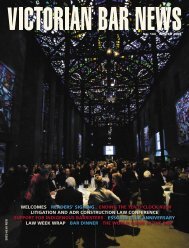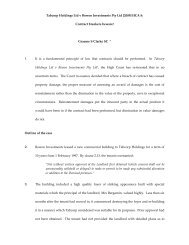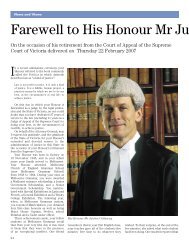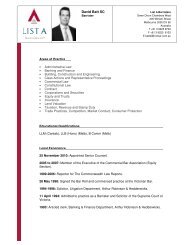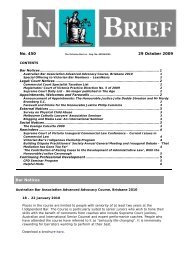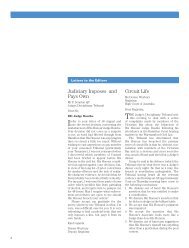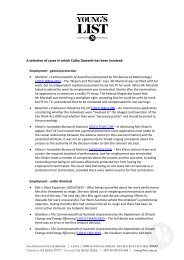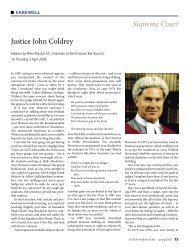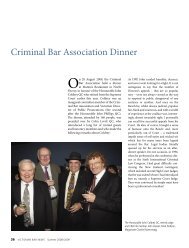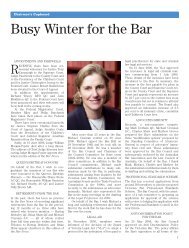Justice William Charles Crockett AO - Victorian Bar
Justice William Charles Crockett AO - Victorian Bar
Justice William Charles Crockett AO - Victorian Bar
- No tags were found...
Create successful ePaper yourself
Turn your PDF publications into a flip-book with our unique Google optimized e-Paper software.
36686(1)(b)(iii) is designed to avoid thenecessity of setting aside a conviction forminor or ‘harmless’ errors of law wherethe Crown can establish that no substantialwrong or miscarriage of justice hasoccurred.”[30] The case law is replete with examplesof situations where either the trivialityof the error itself, or the lack ofprejudice caused by a more seriouserror of law, justified the applicationof the curative proviso. In all thosecases, the appellate courts wereconvinced that the error could havehad no effect on the verdict. Becauseof the nature of the errors and of theissues with respect to which they weremade, it was possible to trace theireffect on the verdict and ensure thatthey made no difference. Generally,the errors concerned evidence thatwas insignificant to the determinationof guilt or innocence or benefited theaccused by imposing a more onerousstandard on the Crown. Errors in thecharge to the jury respecting a veryminor aspect of the case that could nothave had any effect on the outcome orconcerning issues that the jury wasotherwise necessarily aware of werealso cured by the application of theproviso. Similarly, in some cases theerrors concerned preliminary findingsthat would nevertheless, as a matterof law, inevitably have resultedin the same finding made by the trialjudge.[31] In addition to cases where only a minorerror or an error with minor effects iscommitted, there is another class ofsituations in which s.686(1)(b)(iii)may be applied. This was described inthe case of R. v S (PL) [1991] 1 SCR909 at p. 916, where, after stating therule that an accused is entitled to anew trial or an acquittal if errors of laware made, Sopinka J. wrote:There is, however, an exceptionto this rule in a case in which theevidence is so overwhelming thata trier of fact would inevitablyconvict. In such circumstances,depriving the accused of a propertrial is justified on the ground thatthe deprivation is minimal whenthe invariable result would beanother conviction.Therefore, it is possible to apply thecurative proviso even in cases whereerrors are not minor and cannot besaid to have had only a minor effecton the trial, but only if it is clear thatthe evidence pointing to the guilt ofthe accused is so overwhelming thatany other verdict but a convictionwould be impossible. [Some citationsomitted; further emphasis added.]Thus it may be observed that theCanadian test seems to revolve aroundinevitability of result which, as we haveseen, is one of the matters which animatedCallaway JA’s judgment in the Court ofAppeal in Weiss. It is surprising that theHigh Court apparently paid no regard tothe entrenched Canadian position whenso revolutionising the application of theproviso for Australian courts.NEW ZEALAND COURTS REJECTWEISSWeiss has not been followed in NewZealand.In R v Sungsuwan [2006] 1 NZLR 730,two of the Judges of the Supreme Court,Elias CJ 21 and Tipping J, 22 considered thatthe New Zealand proviso 23 could properlybe applied in situations where the groundunder s.385(1)(b) (wrong decision on aquestion of law) had been made out.The approach in New Zealand is eitherthe “this jury” test or the “any reasonablejury” test. Thus in R v McI [1998] 1 NZLR696 Thomas J 24 said of the application ofthe proviso:In my view, it is clear Parliament did notwant convicted persons to go free or obtainthe benefit of a new trial on the basis ofan error of law or irregularity unless theerror or irregularity would have made adifference to the outcome ... The questiontherefore becomes; on the whole of theadmissible evidence, could a reasonablejury have failed to convict?... The necessaryconsequence of the proviso is that itis not every error of law or breach of therules of evidence or procedure which haveevolved to ensure a fair trial for an accusedwhich is necessarily fatal. Any such erroror irregularity needs to be material to theoutcome of the trial. Unless it is, no injusticehas been done. The impact of the factthe proviso has been enacted cannot beignored. In enacting it, Parliament clearlyindicated that it is not every lapse or breachof the rules of procedure or evidence, eventhough the lapse or breach may amount to amiscarriage of justice, which need result ina successful appeal. [Emphasis added.]And Tipping J 25 observed:[I]t is important to recognise that the Courtis not thereby invited to come to its ownview about whether the appellant was infact guilty of the crime or crimes alleged.Rather, the Court is required to assesswhether, without the error or deficienciesof process, the jury would still have convicted.It is what the jury would have donewithout the errors or deficiencies which isthe issue, not what the Court thinks of theultimate merits of the conviction. If, in spiteof the errors or deficiencies, the jury wouldhave convicted anyway, there can be noprejudice to the appellant from those errorsor deficiencies... [T]he test for applicationof the proviso should be framed as follows.Before the proviso may be applied,this Court must be sure that the jurywould without doubt have convicted hadthe matter or matters giving rise to theinitial miscarriage of justice not beenpresent. [Emphasis added.]In R v Howse [2003] 3 NZLR 767 at[45] the New Zealand Court of Appealendorsed these views. On appeal, thePrivy Council affirmed statements of thelaw in Australia (pre-Weiss) 26 to a similareffect and said the proviso applied only incases where the dismissal of the appealwould not countenance a “radical or fundamentalerror”. 27Weiss specifically was consideredby the Court of Appeal in R v Haig[2006] NZCA 226. 28 <strong>William</strong> Young Pand Chambers J said that “[d]espite theEnglish and Australian decisions to whichwe have referred, the weight of authorityin this jurisdiction is such that we think itappropriate to continue to apply the existingNew Zealand principles” .29HOW IS THE PROVISO NOW TO BEAPPLIED?As has been seen, Weiss now dictatesthat an appellate court is to approachthe application of the proviso in the sameway as it approaches a complaint that averdict is unsafe and unsatisfactory. Thisraises the question, what room is left forthe second and third grounds of s.568(1),which permit appellate intervention ifthe judgment of the court before whichthe appellant was convicted should beset aside on the ground of a wrong decisionof any question of law, or if on anyground there was a miscarriage of justice?To answer this question it is necessary todetermine for what Weiss stands.The following observations from Weisscontain the ratio:[41] [The statutory task of applying theproviso] is to be undertaken in thesame way an appellate court decideswhether the verdict of the jury



